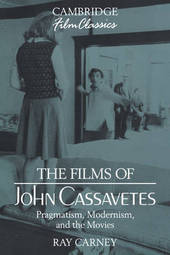
|
The Films of John Cassavetes: Pragmatism, Modernism, and the Movies
Hardback
Main Details
| Title |
The Films of John Cassavetes: Pragmatism, Modernism, and the Movies
|
| Authors and Contributors |
By (author) Ray Carney
|
| Series | Cambridge Film Classics |
|---|
| Physical Properties |
| Format:Hardback | | Pages:336 | | Dimensions(mm): Height 234,Width 156 |
|
| Category/Genre | Films and cinema |
|---|
| ISBN/Barcode |
9780521381192
|
| Classifications | Dewey:791.43092 |
|---|
| Audience | | Tertiary Education (US: College) | | General | | Professional & Vocational | |
|---|
| Illustrations |
35 Halftones, unspecified
|
|
Publishing Details |
| Publisher |
Cambridge University Press
|
| Imprint |
Cambridge University Press
|
| Publication Date |
25 March 1994 |
| Publication Country |
United Kingdom
|
Description
The first book to tell in detail the story of a maverick filmmaker who worked outside the studio system. Providing extended critical discussion on six of his most important films (Shadows, Faces, Minnie and Moskowitz, A Woman Under the Influence, The Killing of a Chinese Bookie, and Love Streams), Ray Carney argues that Cassavetes' work is a distinctly life-affirming form of modernist expression that is at odds with the world-denying modernism of many of the most important art works produced in this century. Cassavetes is revealed to be a profoundly thoughtful and self-aware filmmaker and a deeply philosophical thinker, whose work takes its place in the American tradition along with the writing of Ralph Waldo Emerson and William James. The six films treated here emerge as expressive interpretations of the bewildering challenges in contemporary American cultural experience.
Reviews"...it is a special event...when Carney publishes a book that illustrates what film study and analysis can be at their most visionary and inspiring. Carney is clearly a born teacher...Every page of The Films of John Cassavetes is informed by the passion of a man on a mission to change the way movies are thought and written about. Carney has an extraordinarily exalted vision of the function of cinematic art. Film is, for him, neither escapist entertainment and recreation...nor an intricate stylistic game played off to one side of life...but a way of exploring the most important and complex aspects of human experience." Diane Cherkerzian, The Boston Globe "One of the most exciting aspects of this book is the impression it conveys that absolutely everything is open to reappraisal and revaluation...Not the least innovative aspect of Carney's writing is the degree to which it is radically interdisciplinary, and he sketches a series of strikingly original (yet persuasive) connections between Cassavetes' work and that of other American artists and thinkers...I turned the pages, almost holding my breath at moments, startled by the depth, power and unexpectedness of the argument, emotionally suspended between exhilaration and fear." Diane Cherkerzian, The Boston Globe "...reflects not only years of devotion to Cassavetes' work but also numerous conversations and interviews that the author had with the filmmaker, his colleagues and his friends...Carney's descriptions...are reinforced by the many photographs he provides of Cassavetes energetically working on scenes and individual moments with his actors and crew...Far from mere illustrations of the text, however, these 'inside photos'--published in this book for the first time--reinforce the focus of Carney's book." Filmmaker "Carney's approach to Cassavetes is shaped by the depth and discipline of scholarly analysis, and also by the out-and-out enthusiasm of a movie-lover writing about some of his favorite pictures." The Christian Science Monitor "There is plenty of sturdy analysis here and... Carney makes a strong case for his subject." Times Literary Supplement
|